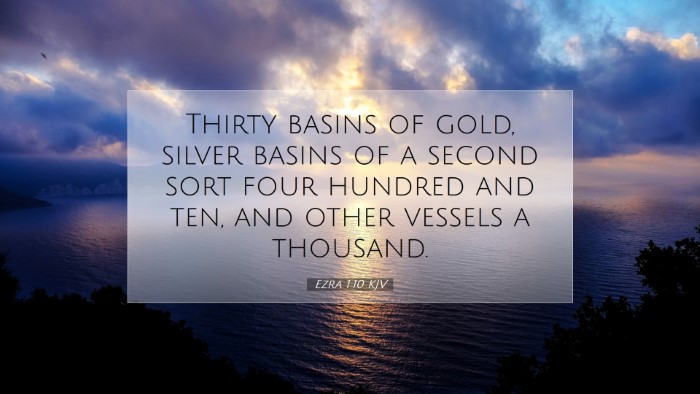Old Testament
Genesis Exodus Leviticus Numbers Deuteronomy Joshua Judges Ruth 1 Samuel 2 Samuel 1 Kings 2 Kings 1 Chronicles 2 Chronicles Ezra Nehemiah Esther Job Psalms Proverbs Ecclesiastes Song of Solomon Isaiah Jeremiah Lamentations Ezekiel Daniel Hosea Joel Amos Obadiah Jonah Micah Nahum Habakkuk Zephaniah Haggai Zechariah MalachiEzra 1:10
Ezra 1:10 KJV
Thirty basins of gold, silver basins of a second sort four hundred and ten, and other vessels a thousand.
Ezra 1:10 Bible Commentary
Commentary on Ezra 1:10
Ezra 1:10 reads: "And thirty basins of gold, a thousand basins of silver, and twenty knives;" This verse highlights the diverse and significant contributions made towards the restoration of the temple in Jerusalem. In this commentary, we will delve into the theological implications, historical context, and practical applications derived from this verse, drawing insights from reputable public domain commentaries.
Historical Context
The book of Ezra begins during the Babylonian captivity and follows the return of the Jewish exiles to Jerusalem. The decree of Cyrus, king of Persia, allows the Israelites to return and rebuild their temple. This context is crucial as it illustrates God's faithfulness to His people and His sovereignty over nations.
- Matthew Henry notes that God stirred the heart of Cyrus, illustrating how God can influence leaders for His purposes. The mention of various items signifies the restoration of proper worship.
- Albert Barnes emphasizes that the importance of the vessels lies in their sacred significance. These items were not merely contributions; they were integral for the worship of the God of Israel.
- Adam Clarke comments on the specific numbers mentioned, suggesting that they serve both a literal and symbolic purpose, reflecting God's abundance and the communal effort involved in the restoration process.
Theological Insights
Ezra 1:10 also provides deep theological insights relevant to both ancient and modern readers.
- Divine Providence: The involvement of Cyrus as an instrument of God's purpose reminds believers of divine providence. God uses all circumstances and people to fulfill His plans.
- Restoration and Worship: The various basins and utensils highlight the significance of the temple's restoration, which is symbolic of spiritual renewal for God's people. The items serve as a reminder that worship requires preparation and the right resources.
- Community Participation: The collective contribution of gold and silver basins signifies the importance of community effort in spiritual endeavors. Each contribution, large or small, holds value in the tapestry of God's work.
Application for Pastors and Theologians
This verse serves as a reminder for pastors and theologians regarding the prioritization of worship and the means through which worship is facilitated.
- Encouraging Generosity: Like the exiles who contributed to the temple, church leaders today can inspire their congregations towards generosity, emphasizing that contributions are vital for the mission of the church.
- Fostering Unity: The collaborative effort in bringing back the temple vessels invites pastors to foster unity within their congregations, acknowledging that collective worship is essential to experiencing God's presence.
- Emphasizing Worship: This passage emphasizes that worship is not a solitary act but a community effort requiring preparation. Leaders are called to cultivate a culture of reverence and preparation for worship.
Cultural Relevance
Understanding the cultural implications of Ezra 1:10 enriches our comprehension of the text. The restoration of the temple was not merely an architectural endeavor but a vital aspect of Jewish identity and faith.
- Cultural Heritage: The temple vessels represent not only a return to worship but also a reclaiming of cultural heritage and identity for the Jewish people. They symbolize the restoration of their place within the covenant community.
- Rebuilding after Exile: For modern readers, the recovery of lost cultural and spiritual identity mirrors experiences in contemporary society where communities must rebuild after dislocation or upheaval.
Conclusion
In summary, Ezra 1:10 holds rich theological and practical insights for contemporary readers, emphasizing the importance of community in worship, the role of divine providence in restoration, and the reestablishment of cultural identity. By examining these insights through the lenses provided by Matthew Henry, Albert Barnes, and Adam Clarke, we gain a deeper understanding of God's ongoing work in the lives of His people.


